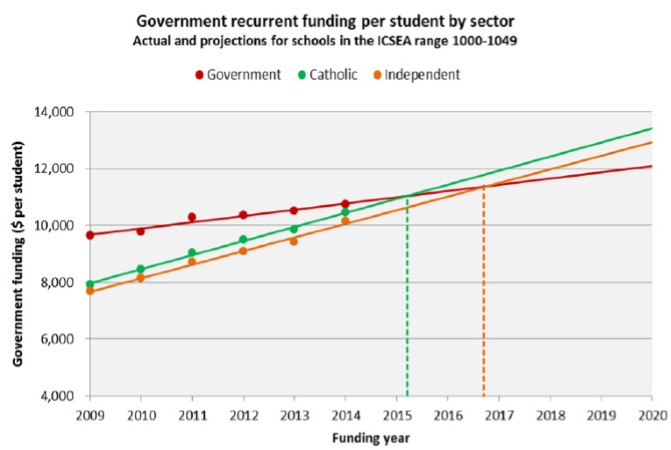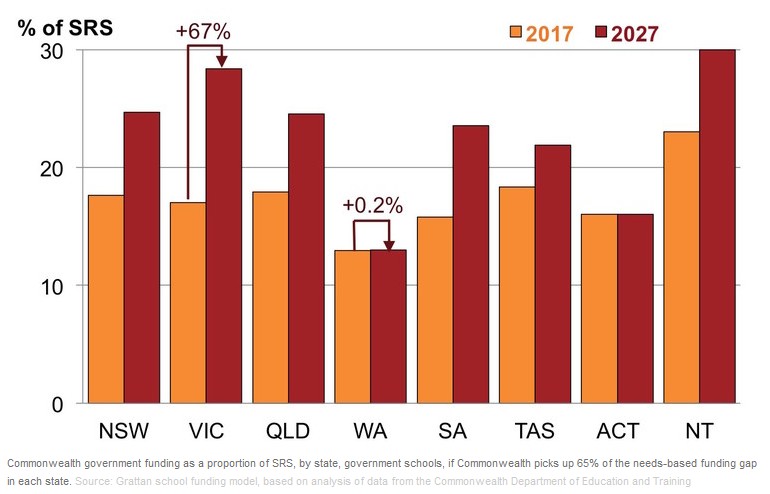The Turbull Government and Labor continue to bicker over the funding of schools, and whose spending plans are closer to the original intent of the Gonski needs-based funding model.
Analysis suggests that the Coalition’s funding package is essentially what Gonski had in mind, with Peter Goss of the Grattan Institute contending that the lion’s share of the extra $22 billion that Labor promised to spend at the 2016 election would represent wasteful investment that would not deliver any notable improvement in student outcomes. From The Conversation:
Labor, backed up by the Australian Education Union, insists that nothing less than “the full Gonski” is worth contemplating. Further, they claim that this requires an extra A$22 billion over the next decade.
Surely more money is a good thing?
Not so fast. Money can’t be spent twice, so funds must be directed where they will have the most impact. Thus, we must analyse why Labor’s plan is so much more expensive than the Coalition’s. Each component can then be considered on its merits.
To save you the trouble, I crunched the numbers. My estimates are necessarily rough, given that the different components cannot always be cleanly separated. But the overall picture is clear. Most of Labor’s extra $22 billion is not directed according to student need, and would have little impact on outcomes…
Every school has a target level of government funding, called its Schooling Resource Standard (SRS)… about 1% of schools already receive well more than their target, costing about $200 million each year. Under Labor’s model, these schools would get funding increases of 3%, per student, per year.
Separately, Australian Capital Territory (ACT) Catholic schools are over-funded to the tune of about $45 million a year, courtesy of a special deal that treats them as comparable to Catholic schools across the nation, despite the fact that they are considerably more advantaged.
Added together, over-funding schools wastes roughly $2-2.5 billion over a decade…
Every year, per-student costs go up, largely driven by teacher wages. To account for this, both Labor’s plan and Gonski 2.0 include annual indexation of the SRS target.
The problem with Labor’s plan is that the indexation rate was fixed at 3.6% in the 2013 Education Act. As Grattan Institute’s Circuit Breaker report shows, this rate is now too high given historically low wages growth.
Gonski 2.0 removes the fixed indexation rate in 2021, replacing it with a floating indexation rate that is more in line with school costs.
Compared to this, Labor’s plan costs $2-2.5 billion more over a decade. This is enough to hurt government budgets, but the extra money is spread so thinly that it would have minimal impact on student outcomes…
Sweetheart deals waste at least $2 billion… Under the current legislation, however, all schools within an education system (for example, Catholic, Anglican or Lutheran schools) are rated as having the same capacity to contribute. This means – for the purposes of calculation – that the parents are treated equally, whether they live in Toorak or Toowoomba.
This “system-weighted average” costs the Commonwealth about $300 million per year. A related quirk in the calculation of capacity to contribute for primary schools adds another $200 million per year.
The main beneficiaries are Catholic primary schools in affluent neighbourhoods, which use the funds to keep their fees artificially low.
Gonski 2.0 removes these sweetheart deals; Labor, which put them in there in the first place, would keep them…
Back in 2013, federal Labor offered to pick up the lion’s share of whatever money was needed to get schools to their target.
This generous approach has perverse impacts. Western Australia, which funds its government schools well, gets nothing extra from the Commonwealth. Victoria, which does not, gets rewarded.
By 2027, these differences are stark. Victoria would get a two-thirds boost in its Commonwealth funding (on top of enrolments and indexation), such that its students get 28% of their SRS target from Canberra. WA students are left languishing at a paltry 13%. These huge differences are not driven by student need, but by discrepancies in state funding.
Removing this inequity is a central element of Gonski 2.0: once fully implemented, all government schools will get 20% of their target from the Commonwealth, and all non-government schools 80%.
Labor’s model adds about $8 billion to the Commonwealth’s tab over a decade, money that should be stumped up by states…
If Labor believes Australian schools need $22 billion more than the Coalition is offering, ambit claims won’t cut it. It must explain how its additional funding will benefit students. And soon.
Peter Goss’ arguments make prima facie sense. Last year’s report, entitled Uneven Playing Field: The State of Australia’s Schools, projected that the original botched Gonski settings would have seen non-government school students – and those in Catholic schools in particular – receiving greater taxpayer funding than average public school students by 2020:

How Labor can support such an inequitable outcome beggars belief. The fact that Gonski 2.0 is seeking to remove some funding from privileged schools, saving the Budget billions, seems entirely sensible, represents good policy, and should be supported.


